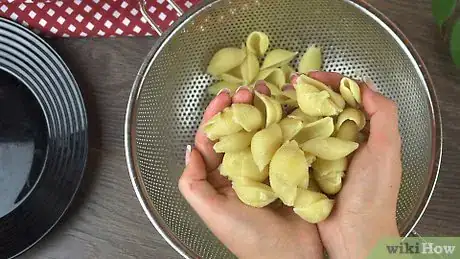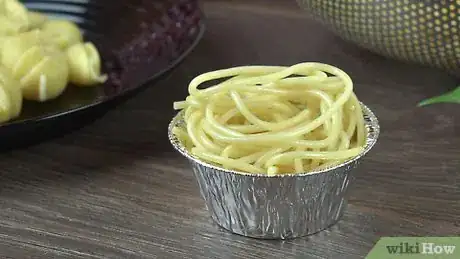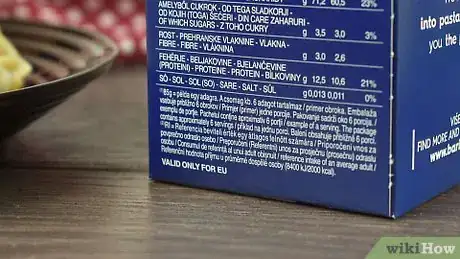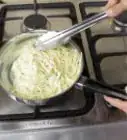This article was co-authored by Abyssinia Campbell and by wikiHow staff writer, Janice Tieperman. Abyssinia Campbell is an Executive Chef and the Owner of Chef Abyssinia, Personal Chef and Catering. With over ten years of experience, she specializes in catering, event planning, menu development, meal planning, and food business operations. When it comes to cooking, Chef Abyssinia enjoys using fruits, vegetables, healthy food alternatives, and local farm-fresh ingredients. She holds a BASc in Culinary Arts and Food Service Management from Johnson and Wales University.
This article has been viewed 38,840 times.
According to the USDA, 2 ounces of dry pasta is the recommended serving size for an adult. If you’ve already prepared your noodles, you may be wondering how you can measure out an accurate serving of cooked pasta! Don’t worry—with a measuring cup or digital scale, you can easily measure out exact servings. If you aren’t looking for a precise measurement, there are several simple ways to determine an approximate serving of cooked pasta.
Steps
Measuring Precise Portions
-
1Measure out 1 cup (140 g) of cooked spaghetti for a large serving. Take a standard measuring cup and fill it to the brim with cooked noodles. If you’d prefer to be more precise, place the noodles in a small container and rest them on a food scale. Continue adjusting the portion until the scale reads 140 g.[1]
- For those looking to have a smaller portion, measure out ½ cup (70 g) of long pasta instead.
- If you want to be extra thorough, check the nutrition facts on the pasta box to see what the suggested serving size is.
-
2Prepare 1⅛ cup (220 g) of elbow or shell pasta to make 1 large portion. Scoop out a standard cup (200 g) of elbow or shell noodles into a separate container, then add in an extra ⅛ cup (20 g) of pasta.[2] Aim to use a digital scale whenever you measure food, as these devices are easier to read and monitor. When you do this, try placing your pasta into a separate bowl or container and placing it on a food scale and comparing the measurement to the listed portion on the pasta box.[3]
- If you’re looking to have a smaller, kid-sized portion, measure out a heaping ½ cup (110 g) of noodles.[4]
Advertisement -
3Measure out 1¼ cup (250 g) of penne, rigatoni, or ziti to get a large serving. Scoop about 1 cup (200 g) of larger short-cut noodles into a separate bowl or container, then add another ¼ cup (50 g) into the serving. If you’d like to double-check your servings, place the portion of pasta onto a digital food scale. Check the reading by comparing it to the portion size listed in grams on the side of the pasta box.[5]
- Since these pasta types might not pack evenly into a single cup, it might be useful to measure them by weight.
- For those looking to eat a smaller portion, split that amount of pasta in half (125 g).
Estimating Serving Sizes
-
1Fill both hands with cooked pasta to approximate a single adult serving. Scoop some cooked pasta into your hands to figure out an approximate serving. Fill both cupped hands with pasta to get a 1 cup serving (140-200 g). Keep in mind that the specific weights of the pasta will differ depending on type (e.g., spaghetti, rigatoni, etc.) [6]
- If you’re looking for a smaller portion, just fill 1 cupped hand with pasta (70-100 g).
-
2Fit your noodles into a muffin tin to get a kid-sized serving. Pull out a muffin tin and scoop the cooked pasta noodles into the muffin cups. For those who prefer a larger, adult-sized (140 g), use 2 muffin tins as a reference instead. You can also freeze or refrigerate the noodles in the muffin tin if you’d prefer to eat them later.[7]
- If you’re looking to eat a smaller, ½ cup (70 g) portion of pasta, only use a single muffin tin as a serving reference.
-
3Compare ½ cup (100 g) of pasta to the size of a computer mouse. Examine the portion of cooked pasta that you’ve dished out for yourself. Is it round, or about the size of your fist or a computer mouse? If so, then you’ve successfully dished yourself a kid-sized serving of pasta.[8]
- If you’d prefer to have a larger portion of pasta, scoop 2 computer mice-worth of noodles onto your plate.
-
4Split the cooked noodles into equal portions if you cooked the whole box. Check the bag or box to see how many adult-sized servings are in the entire container. Once you’ve prepared the pasta, divide the food into the number of portions specified on the box. If you’d like to save some pasta for later, divvy up a single serving of cooked pasta into an individual bag and refrigerate it![9]
- If you’re splitting the pasta into kid-sized portions, multiply the number of servings listed on the box by 2.
References
- ↑ https://www.thekitchn.com/ounces-to-cups-a-guide-to-estimating-pasta-yield-179180
- ↑ https://www.thekitchn.com/ounces-to-cups-a-guide-to-estimating-pasta-yield-179180
- ↑ http://www.pbs.org/food/fresh-tastes/five-reasons-to-use-a-kitchen-scale/
- ↑ https://www.thekitchn.com/ounces-to-cups-a-guide-to-estimating-pasta-yield-179180
- ↑ https://www.thekitchn.com/ounces-to-cups-a-guide-to-estimating-pasta-yield-179180
- ↑ http://happyhealthy.extension.msstate.edu/tips-videos/how-measure-food-using-your-hands
- ↑ https://www.tasteofhome.com/article/how-to-measure-pasta
- ↑ https://smokefree.gov/stay-smokefree-good/eat-healthy/how-much-one-serving
- ↑ https://www.today.com/series/how-often-should-you/how-often-you-should-clean-your-dryer-right-way-do-t77396





















































